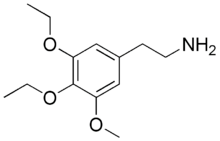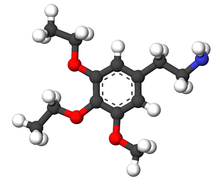Asymbescaline
 | |
 | |
| Names | |
|---|---|
| IUPAC name
3,4-Diethoxy-5-methoxyphenethylamine | |
| Other names
2-(3,4-Diethoxy-5-methoxyphenyl)ethanamine | |
| Identifiers | |
3D model (JSmol) |
|
| ChEMBL | |
| ChemSpider | |
PubChem CID |
|
| |
| |
| Properties | |
| C13H21NO3 | |
| Molar mass | 239.31 g/mol |
Except where otherwise noted, data are given for materials in their standard state (at 25 °C [77 °F], 100 kPa). | |
| Infobox references | |
Asymbescaline, or 3,4-diethoxy-5-methoxyphenethylamine, is a lesser-known psychedelic drug. It is a homologue of Mescaline. Asymbescaline was first synthesized by Alexander Shulgin. In his book PiHKAL (Phenethylamines i Have Known And Loved), the dosage range is listed as 200–280 mg, and the duration listed as 10–15 hours. Asymbescaline produces few to no effects.[1] Very little data exists about the pharmacological properties, metabolism, and toxicity of Asymbescaline.
See also
References
- ↑ Shulgin, Alexander; Ann Shulgin (September 1991). PiHKAL: A Chemical Love Story. Berkeley, California: Transform Press. ISBN 0-9630096-0-5. OCLC 25627628.
External links
This article is issued from
Wikipedia.
The text is licensed under Creative Commons - Attribution - Sharealike.
Additional terms may apply for the media files.